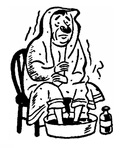
The Fever of Vatican II
ALL FOR NAUGHT
On October 11, 1962, the doors of the Vatican were swung open to the bishops, resplendent in formality and expectation, for they were embarking on a new endeavor. One of the goals of the Second Vatican Council was to bring the world into a more “enlightened era.” The Church’s “Pastoral Constitution on the Church in the Modern World,” Gaudium et Spes, states, “history itself speeds along on so rapid a course that an individual person can scarcely keep abreast of it. The destiny of the human community has become all of a piece, where once the various groups of men had a kind of private history of their own. Thus, the human race has passed from a rather static concept of reality to a more dynamic, evolutionary one. In consequence, there has arisen a new series of problems, a series as important as can be, calling for new efforts of analysis and synthesis” (article 5; emphasis added). The philosophy of the Jesuit evolutionary scientist Pierre Teilhard de Chardin, who was involved in one the greatest and gravest scientific scandals of all time, the Piltdown Man “fossil,” is clearly evident here. If this is the “working of the Holy Spirit,” as many modern prelates pound into the heads of the faithful, then, one may argue, the Holy Spirit Himself is an evolutionary object subject to change. But don’t question this “enlightened” view of reality, or you’ll be labeled a “heretic.” Never mind that Vatican II proclaimed no new dogmas, and thus if a thoughtful person questions a non-dogmatic tenet of this Council, he cannot be termed a heretic, since to constitute heresy, one must deny a dogma of the Church.
Nobody was more jubilant about Vatican II than the secular media. The December 17, 1965, issue of LIFE magazine was headlined “Catholicism’s Epic Venture.” You know there is something askew when a modern, liberal publication is ecstatic about a Catholic Council. John K. Jessup wrote:
Coming at a time when so many human faiths, loyalties and grips on truth are unmoored or slipping, the Second Vatican Ecumenical Council which ended last week must be called the most impressive religious event this century has yet seen…. The spirit of the new era was symbolized by one of the closing events of the council, when the Pope shared with Protestant and Orthodox clergymen the conduct of a prayer and gospel-reading service in the monastic church of St. Paul’s Outside the Walls. This service was not Roman, not Protestant and not Orthodox. It was simply Christian.
“New era” is a term often heard. Supposedly, the “new era” envisioned in the 1960s did not include a wholesale exodus of priests, and many of the remaining priests engaged in pedophilia. The “new era” probably didn’t forecast a reduction in Mass attendance from 75 percent before Vatican II to roughly 30 percent afterward. Forty years ago it wasn’t acceptable to wear short skirts and tank tops to Mass; women wore chapel veils or hats. But most priests are too afraid — too emasculated — to speak out about those blasphemies these days. The sought-after “new era” of the 1960s probably didn’t contemplate that a majority of Catholics in 2006 would support abortion and contraception, priestesses, and other “progressive” trends. The “new era” probably didn’t anticipate that although roughly 70 percent of Catholics today don’t believe in the Real Presence of Christ in the Eucharist, they would be all too eager to line up to take the Eucharist in an unworthy manner from relaxed lay ministers passing out the Body of Christ, hand to hand.
You May Also Enjoy
Pledging Allegiance... No Horsing Around... The Heights of Relaxation... Meat in a Minute... A King’s Ransom... Too Cute for the Can... and more
On Michael Novak's Conversion... Christmas Presents No One Needs... Mormon Missionaries... On Jonathan Edwards
The priest and school rector demanded a retraction and apology from the concerned parents or they would not be permitted to enroll their children in the parish school.

